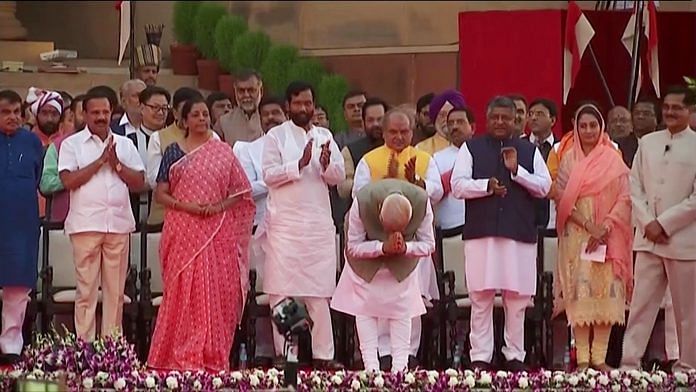New Delhi: As he began his second innings, Prime Minister Narendra Modi’s new council of ministers remained largely expected, sprinkled with a few surprise entries and some unexpected ousters.
The big takeaways from the 58-member cabinet that took oath late Thursday evening in a grand ceremony at Rashtrapati Bhavan were the inclusion of Bharatiya Janata Party (BJP) president Amit Shah as a top cabinet minister, the surprise induction of ex-foreign secretary S. Jaishankar and the high-profile ousters of former external affairs Sushma Swaraj and former women and child development minister Maneka Gandhi. Swaraj had opted against contesting the Lok Sabha polls.
Among those dropped were Radhamohan Singh, Uma Bharti and Anant Geete. The JD(U) chose to stay out of the cabinet as Nitish Kumar’s demand for three ministerial berths was not accepted. BJP’s southern ally, AIADMK, also did not get any representation in the government.
While former finance minister Arun Jaitley had already opted out of the cabinet, the fact that Swaraj did not contest the polls and has health concerns had triggered speculation that she would not be part of the new government. It was a similar case with another prominent minister, Uma Bharti, who had also not contested the elections.
Also evident were the Modi-Shah duo’s attempts to bring out some sort of a regional balance by including political leaders from across key states — Gujarat, Uttar Pradesh, Rajasthan, Maharashtra, Jharkhand, Karnataka, Uttarakhand, Madhya Pradesh, Haryana, Bihar, West Bengal, Kerala, Assam, Telangana and Odisha — both as junior and senior ministers.
Allies Lok Janshakti Party (LJP), Shiromani Akali Dal (SAD) and Shiv Sena also found representation through Ram Vilas Paswan, Harsimrat Kaur, who was a cabinet minister in the last government as well, and Arvind Sawant respectively. The BJP allies got one berth each in government.
A total of 58 ministers, including PM Modi, took oath.
In the outgoing government, there were 25 cabinet ministers, 11 ministers of state (MoS) with independent charge and 34 MoS’, taking the total strength of the council of ministers to 71 including the PM.
The portfolios for the second Modi government had not been announced until the time of publishing this report.
Also read: Ex-foreign secy S. Jaishankar makes surprise comeback as minister in Modi’s new govt
The gainers
Shah’s transition from the party to the government was much-talked about and hardly unexpected. But it is Jaishankar’s entry that caused ripples and indicated how this version of Modi may be willing to look beyond the obvious to address the biggest criticism his earlier government received — of a talent crunch.
A 1977-batch officer of the Indian Foreign Service, Jaishankar has been a recipient of the Padma Shri and was at the forefront of the diplomatic efforts to defuse the 2017 Indo-China Doklam crisis.
To add a dash of youth, the MP from Hamirpur in Himachal Pradesh, Anurag Thakur, has also been brought in.
Pratap Sarangi, a key BJP face in Odisha — a state where the party made inroads — has been brought in, as has Debasree Choudhary from West Bengal and Rameswar Teli of Assam, two other states where the party did exceedingly well.
Former home minister Rajnath Singh was the first to take oath after the PM, followed by Shah, Nitin Gadkari, D. Sadananda Gowda, Nirmala Sitharaman, and Paswan. Interestingly, Jaishankar took oath before dynasty-slayer Smriti Irani, former chief ministers Ramesh Pokhriyal and Arjun Munda, as well as BJP leaders like Harsh Vardhan, Prakash Javadekar and Piyush Goyal.
The big losers
Maneka Gandhi, who has been part of all BJP governments ever since Atal Bihari Vajpayee became prime minister in 1998, has been a surprise exclusion.
Her controversial remarks during her previous stint as a minister and taking a stance contrary to her government could have cost her a place in this government.
Other big misses include Jayant Sinha, former MoS with independent charge of civil aviation, and former union minister Suresh Prabhu.
Former health minister J.P. Nadda has not been inducted into the council, thus adding to the speculation of him taking over from Shah as the next BJP president.
Also excluded was former Information and Broadcasting Minister (MoS with IC) Rajyavardhan Rathore, who looked on from the audience as his colleagues were sworn in.
Also read: BJP chief Amit Shah becomes top minister – insight into the rise of the party commissar




I am very happy at the exclusion of Jayant Sinha and Rajyavardhan Rathore. Despite his pleasing manners, high-Ed background etc, Sinha showed us that “ambition is bigger than propriety” when he garlanded some criminals and also had himself photographed with all of them, still in garlands, to rub it in. Rathore just didn’t know how to handle power with grace. He thought the best way to handle someone who questioned you was to start barking at him.
Now my only question is, if Adityanath can be the chief minister of UP, why can Giriraj Singh not be the home minister of India?